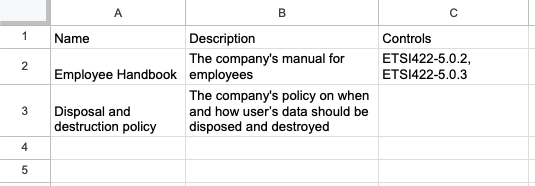Importing labels
Roles and permissions
The following roles can import labels:
Administrators
Compliance managers
Users
If your organization has already developed its own set of labels, you can import them into Hyperproof via CSV.
Tip
Adding additional information does not overwrite existing data. During the import, Hyperproof searches for any exact data identifiers. If it doesn’t find any, it treats the data as new. If it finds a match, it updates the existing data.
Step One: Downloading the example CSV
The easiest way to start importing your own labels is by downloading Hyperproof’s example CSV. The example CSV file provides the exact template for successfully importing labels into Hyperproof.
From the left menu, select Labels.
Click Import.
The Import labels window opens.
Click Download the example CSV.

Step Two: Editing the CSV
Replace the contents of the example CSV file with your own labels, descriptions, and optionally, controls. Be sure to follow the format of the example file, as well as the instructions on the page, to ensure that your labels can be successfully imported.
Note
The CSV must contain ALL headings listed below, even if they are optional. Keep in mind that headings are case-sensitive!
Heading | |
|---|---|
Name | Should contain a label name that's unique to your organization. This field is required. Tip: If the label name is not unique, this row is skipped. |
Description | This is the full definition of the label. It can be a multi-line string. This is an optional field. |
Controls | This field links the label to one or more controls in your organization. This is an optional field. Tip: You can enter a single control ID or multiple IDs. The format for a single ID is CC1.4 . The format for multiple controls is CC7.3, CC7.5, CC7.9. |
Custom fields |
Below is a snippet of a sample import file.

Tip
Looking for more example labels? This example import sheet is a great starting point.
Step Three: Importing the CSV
After you’ve made the necessary changes to the CSV, it can be imported into Hyperproof.
Drag and drop the CSV file into the Upload CSV File field, or click Select file to upload to upload it manually.
Click Import.
Hyperproof checks the CSV to ensure that there are no errors. You’ll be alerted if Hyperproof encounters any errors.
If Hyperproof didn’t detect any errors, click Next. If Hyperproof detected errors, do one or both of the following:
First, use the Error viewer to identify the errors. Second, correct the errors directly in the CSV. This ensures that the CSV is up-to-date should you need to re-import in the future.
Tip
Use the forward and backward arrows to cycle through the errors. The Error viewer gives specific information on what needs to be corrected.
Remove rows that contain errors by clicking Remove all rows with errors. Note that this doesn't remove any data in the actual CSV.
Click Next.
The CSV is imported.